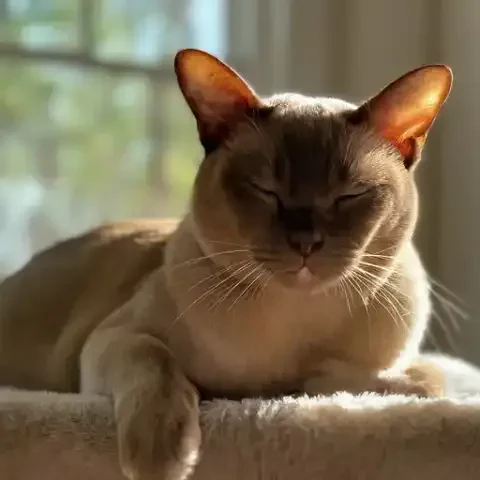Finding cat pee outside the litter box? You're not alone! It's a common, and often baffling, problem for cat owners. The sudden appearance of urine or feces in unexpected places around your home can be incredibly frustrating and, let's be honest, a little worrying. You might find yourself wondering, "Is my cat being spiteful? Are they mad at me?" But take a deep breath and try to resist the urge to assume your feline friend is engaging in "bad" behavior. More often than not, litter box avoidance isn't about intentional naughtiness at all. Instead, it's usually a cry for help, a symptom, a signal that something is amiss in your cat's world – whether it's physical discomfort, a problem with their litter box setup, or emotional distress. Understanding the "why" behind this change in behavior is absolutely crucial. It's like being a feline detective, piecing together clues to figure out what's prompting your cat to go outside their designated bathroom. Only by understanding the root cause can you hope to find a lasting and effective solution. This article is designed to be your comprehensive guide, your toolkit for decoding the mysteries of litter box avoidance. We'll explore the common reasons behind this behavior, from medical concerns to litter box setup issues and stress factors, and, most importantly, we'll equip you with actionable steps and practical solutions to get your cat back to happily using their litter box and restore peace and harmony (and cleanliness!) to your home. So, let's embark on this journey together, with a reassuring and solution-oriented approach, and unravel the secrets of litter box mysteries, empowering you to understand and help your feline companion.
Let's start by becoming feline behavior detectives and decoding the most common reasons behind litter box avoidance. And the very first, and most critical, area to investigate is your cat's physical health. If your cat suddenly stops using the litter box, a veterinary check-up should be your absolute first step. Ruling out medical issues is not just important; it's paramount. Often, underlying medical conditions are the silent culprits behind this change in elimination habits, and addressing these issues is the key to resolving the problem. Urinary tract issues are among the most frequent medical reasons for litter box avoidance in cats. Conditions like urinary tract infections (UTIs), cystitis (bladder inflammation), and the formation of crystals or stones in the urinary tract can cause significant pain, discomfort, and a sense of urgency to urinate. Imagine the discomfort and pain associated with these issues; it's no wonder a cat might start associating the litter box itself with that pain, leading to avoidance. Pay close attention to symptoms that might indicate urinary problems. Straining to urinate, frequent trips to the litter box with little urine production, blood in the urine, and vocalizing or crying out while in the litter box are all red flags that warrant immediate veterinary attention. If your cat is displaying any of these symptoms, a vet visit is non-negotiable. Your veterinarian will perform a thorough examination and likely run a urinalysis to diagnose or rule out urinary tract issues. Treating the underlying medical condition, often with antibiotics for UTIs or dietary changes for crystal management, is usually the first and most crucial step in resolving the litter box problem if it’s medically related.
Beyond urinary issues, a range of other medical conditions can also manifest as litter box avoidance. Kidney disease, for example, can lead to increased urination as the kidneys struggle to concentrate urine effectively. This increased volume of urine can overwhelm the litter box capacity or create a sense of urgency that makes it difficult for the cat to reach the box in time, especially if the box isn't scooped frequently enough. Diabetes, similarly, can also result in increased urination, again due to the body trying to flush out excess glucose through urine. Hyperthyroidism, an overactive thyroid gland, can lead to increased anxiety and changes in behavior, which, in some cats, can manifest as altered elimination habits. Arthritis and joint pain, particularly common in older cats, can make it physically difficult for a cat to get into or out of the litter box, especially if it has high sides. The discomfort of maneuvering into the box might lead them to seek easier, though less appropriate, elimination spots. Inflammatory Bowel Disease (IBD) or other digestive issues causing diarrhea or increased urgency to defecate can also contribute to accidents outside the litter box. The sudden onset of diarrhea or increased urgency might make it harder for the cat to reach the litter box in time. And for our senior feline companions, cognitive dysfunction, sometimes referred to as feline dementia, can be a factor. Just like in humans with cognitive decline, senior cats can experience forgetfulness, disorientation, and changes in spatial awareness, which might lead to accidents outside the litter box due to confusion or simply forgetting where the box is located. Even pain or discomfort directly associated with the litter box itself, unrelated to internal illness, can trigger avoidance. If your cat has recently undergone surgery, post-operative pain might make them associate the litter box with discomfort, especially if they were placed in the box soon after surgery or received medication near the box. Similarly, if your cat develops a paw injury or infection, certain litter textures might become painful or irritating to walk on, leading them to avoid the box altogether. The key takeaway here is that a thorough veterinary examination is absolutely essential when litter box problems arise. Ruling out these medical conditions is not only critical for addressing the behavioral issue, but more importantly, for ensuring your cat's overall health and well-being. Don't delay a vet visit – it’s the most responsible and loving first step you can take.
Once medical causes have been ruled out (or are being addressed in conjunction with behavioral modifications), the next area to scrutinize is the litter box environment itself. Believe it or not, the box itself can be a major source of feline frustration and the root of litter box avoidance. One common issue is litter box aversion, which essentially means your cat has developed a negative association with the litter box. This negative association can stem from a variety of unpleasant experiences directly linked to the box. Perhaps they experienced pain while urinating in the box due to a UTI, and now, even after the UTI is resolved, they still associate the box with that pain. Or maybe medication was administered near the litter box, creating a negative scent association. A startling noise occurring while they were in the box, like a loud bang or the vacuum cleaner suddenly starting up, could also create a negative link. Whatever the trigger, if a cat develops a negative association with the litter box, it becomes linked to unpleasant feelings in their mind, and naturally, they'll try to avoid it.
The type of litter box itself can also be a significant factor. Consider the debate between covered versus uncovered litter boxes. Some cats are quite particular about their bathroom preferences! Some cats strongly prefer open, uncovered litter boxes. They appreciate the better ventilation, feeling less confined, and having a wider field of vision, allowing them to feel more secure and in control of their surroundings while eliminating. Other cats, however, prefer the privacy offered by covered litter boxes, feeling more secluded and less exposed while doing their business. A sudden change from their preferred box type, or being forced to use a box type they dislike, can lead to avoidance. The size of the litter box is also crucial, especially for our larger feline friends like Maine Coons or even just generally large-bodied cats. A litter box that is too small can be incredibly uncomfortable, making it difficult for a cat to turn around comfortably, dig properly, or find a clean spot to eliminate. Ideally, the litter box should be at least one and a half times the length of your cat. Shape and depth also matter. Some cats are particular about box depth. Some dislike very deep boxes, finding them difficult to maneuver or step into, while others prefer deeper boxes that allow for more digging and burying behavior. High-sided litter boxes, while helpful for containing litter scatter, can become challenging for older cats or cats with arthritis or mobility issues to get in and out of comfortably. And let's not forget automatic litter boxes. While convenient for humans, these self-cleaning boxes can be a source of anxiety or fear for some cats. The sudden noise or motion of the automatic raking mechanism can startle sensitive cats, creating a negative association and leading to avoidance.
The type of litter you use is another critical element in litter box acceptance. Litter preferences are highly individual among cats, and getting it wrong can be a major deterrent. Scented versus unscented litter is a big point of contention for many felines. While scented litter might seem appealing to humans, many cats are actually highly sensitive to strong artificial fragrances and find scented litter overwhelming and off-putting. Most cats prefer unscented litter, finding the artificial scents irritating to their sensitive noses. Switching from unscented to scented litter, or vice versa, can trigger avoidance in cats with strong scent preferences. Texture is another key aspect of litter preference. The texture of the litter under their paws is important to cats. Consider the range of litter textures available: clumping versus non-clumping, clay litter, crystal litter, paper-based litter, pine litter, and more. Cats can develop preferences for specific textures, and a sudden change in litter type, especially to a texture they dislike, can lead to litter box rejection. Some cats are sensitive to the feel of certain litter types on their paws – some prefer soft, fine litter, while others might dislike the feel of large, coarse granules. Even the depth of litter in the box can be a factor. Some cats like to dig and bury extensively, so too little litter might not provide enough digging satisfaction. Conversely, some cats might dislike boxes that are filled too deeply with litter, perhaps feeling it’s too cumbersome to navigate. And finally, we arrive at litter box cleanliness – hygiene is absolutely paramount in the feline bathroom world! Cats are fastidious creatures, renowned for their cleanliness, and they have very high standards when it comes to their litter boxes. Infrequent scooping is a major litter box faux pas in the cat world. Cats dislike dirty litter boxes intensely. The buildup of urine and feces odor is highly off-putting to their sensitive noses and can quickly deter them from using the box. Ideally, litter boxes should be scooped at least once daily, and even better, twice a day, to maintain a fresh and appealing environment. Beyond scooping, the frequency of full litter changes is also essential. Even with regular scooping, litter becomes saturated with urine over time and can harbor bacteria and lingering odors. Therefore, litter boxes need to be fully emptied, cleaned, and refilled with fresh litter regularly, typically at least weekly, or even more often in multi-cat households, to eliminate odor buildup and maintain a hygienic environment. And when you clean the litter box, be mindful of the cleaning products you use. Harsh chemicals or strong-smelling cleaners can be just as deterring as dirty litter. Opt for gentle, unscented cleaning products specifically designed for pet use to avoid leaving behind unpleasant odors that might discourage your cat from using the box.
Beyond the box and its contents, the location of the litter box is another surprisingly influential factor in feline bathroom habits. Placement truly matters! Accessibility is key. Is the litter box easily accessible to your cat at all times? Consider the location in your home. Is it on a different floor from where your cat spends most of their time? Are there obstacles blocking easy access, like furniture or closed doors? These factors can make it less convenient, especially for older cats or those with mobility limitations, to reach the box in time when nature calls. Privacy versus isolation is another aspect to consider. Cats generally prefer some level of privacy while eliminating. A litter box placed in the middle of a high-traffic area, like the living room or hallway, might make them feel exposed and vulnerable, leading to avoidance. However, you also don't want to place the litter box in a completely isolated or scary location, such as a dark, unfinished basement or a noisy laundry room. The ideal location offers relative privacy, away from the hustle and bustle, but still feels safe and accessible. And remember the golden rule of litter boxes, especially in multi-cat homes: the number of litter boxes should ideally be one more than the number of cats in your household (N+1 rule). Insufficient litter boxes can lead to competition for resources, territorial marking issues, and some cats being effectively "boxed out" by more dominant felines. Providing multiple litter boxes in different locations ensures that all cats have readily available and safe bathroom options. Proximity to other resources is another location consideration. Cats are naturally clean and generally prefer not to eliminate near their food and water bowls. Keep litter boxes separate from eating and sleeping areas, ideally in different rooms or at least in different corners of the same room, to respect their natural instincts and preferences. Finally, be mindful of environmental changes that might impact litter box location appeal. Household renovations, furniture rearrangements, the arrival of a new pet, or a new baby – even seemingly minor changes in your cat’s environment can make a previously acceptable litter box location less appealing or accessible. Re-evaluate litter box locations after any significant household changes to ensure they remain suitable and comfortable for your feline companion.
Stress and anxiety are powerful drivers of behavioral changes in cats, and litter box avoidance is often a direct manifestation of emotional upset. Cats are creatures of habit and routine, and any significant disruption to their sense of security and predictability can trigger stress-related issues. Changes in household routine, even seemingly minor ones to us, can be significant stressors for cats. A new work schedule that alters your presence at home, travel that disrupts their daily interactions with you, or frequent visitors in the home can all create anxiety and insecurity in sensitive felines. The arrival of a new pet, whether it's another cat, a dog, or any other animal, is a major household upheaval for existing cats. Introducing a new human family member, such as a new baby or a partner moving in, can also be stressful, disrupting established routines, scent markings, and territory. Moving to a new home is a particularly significant stressor for cats. A new environment is filled with unfamiliar scents, sounds, layouts, and territories, which can be incredibly overwhelming and anxiety-provoking, often leading to behavioral changes including litter box issues. Loud noises or disruptive events in the home can also create stress and insecurity. Construction noises, thunderstorms, fireworks, or even frequent arguments within the household can all contribute to a cat’s overall anxiety level, potentially manifesting as litter box avoidance. Inter-cat conflict and bullying, especially in multi-cat households, is a common but often subtle source of stress that can directly impact litter box habits. One cat might actively block another cat's access to the litter box, engaging in resource guarding behavior, making it difficult or intimidating for the subordinate cat to use the box. Bullying cats might also ambush or harass other cats near the litter box, turning it into a stressful and unsafe place to eliminate for the bullied feline. In such cases, a subordinate cat might avoid the "main" litter box altogether, seeking out safer, but perhaps less appropriate, locations for elimination to avoid confrontation. Even separation anxiety, particularly in cats who are overly attached to their owners, can manifest as litter box problems when owners are away from home. Litter box accidents might become a stress response to the owner's absence, a way of expressing their anxiety and distress.
Now that we've explored the potential reasons, it's time to put on our detective hats and get to work troubleshooting and finding solutions! Here's a step-by-step guide to help you navigate the litter box mystery and get your cat back on track. Step one, and we cannot emphasize this enough, is a veterinary check-up. Rule out medical causes FIRST! Before you start changing litter boxes, litter types, or rearranging furniture, schedule a vet appointment. It's absolutely crucial to rule out any underlying medical conditions that might be causing the litter box avoidance. During the vet visit, expect a thorough physical examination of your cat. Your veterinarian will likely want to perform a urinalysis to check for signs of urinary tract infections, crystals, or other urinary abnormalities. Bloodwork might also be recommended to assess kidney function, blood sugar levels (to rule out diabetes), and thyroid hormone levels (to check for hyperthyroidism), depending on your cat’s age and symptoms. If a medical condition is diagnosed, meticulously follow your veterinarian's treatment plan. Often, simply resolving the underlying medical issue will resolve the litter box problem as the pain and discomfort subside.
Step two involves a thorough litter box environment audit. Think of this as your "5 Ls" checklist: Litter Box type, Litter type, Location, Layers (depth of litter), and Lavatory (cleanliness). Experimentation and adjustments are key here. Start with litter box type experimentation. Try offering different types of boxes to see if your cat shows a preference. Provide both open and covered boxes side-by-side. Experiment with different shapes, sizes, and side heights. If you’ve been using a high-sided box, try offering a lower-sided one, especially if your cat is older or has mobility issues. Observe which box type your cat uses more readily, or seems to prefer. Next, move onto litter type trial and error. If you are currently using scented litter, make the switch to unscented immediately. Offer a choice of different litter textures by placing separate litter boxes side-by-side, each filled with a different type of litter – clumping clay, non-clumping clay, paper-based, crystal, pine, etc. Observe which texture your cat seems to prefer based on usage. Avoid sudden drastic changes in litter. If you do decide to switch litter types, introduce the new litter gradually, mixing it with the old litter over a period of several days to minimize stress and allow your cat to adjust. Experiment with litter depth. Try adjusting the depth of litter in the box. Experiment with using slightly more or slightly less litter to see if your cat has a preference. Now, let's re-evaluate and adjust the location, location, location of the litter box. Ensure the litter box is easily accessible, especially for older cats or cats with mobility limitations. Reassess the privacy versus isolation balance. Is the box private enough but not placed in a scary or inaccessible location? Increase the number of litter boxes, particularly if you have a multi-cat household or a larger home. Place the additional boxes in different locations and on different floors to provide ample options. If the litter box is located too close to food or water bowls, relocate it further away to respect their natural instincts. If you've recently experienced household changes, consider temporarily relocating the litter box to a quieter, less stressful area to provide a sense of stability and comfort. Finally, it’s time for a cleanliness revolution – ramp up litter box hygiene! Commit to scooping litter boxes AT LEAST once daily, and ideally twice a day, to remove urine and feces promptly and minimize odor buildup. Perform a full litter change and thoroughly clean the litter box at least weekly, or even more frequently if needed, especially in multi-cat homes. Use gentle, unscented cleaning products to clean the box, avoiding harsh chemicals or strong fragrances. For accidents that have occurred outside the litter box, use enzyme-based cleaners specifically designed for pet urine. Enzyme cleaners are crucial for breaking down urine odors and discouraging repeat marking in the same spots. Avoid ammonia-based cleaners, as ammonia smells similar to urine and can actually attract cats back to the accident spot.
Step three focuses on stress and anxiety reduction. Creating a calm and secure environment can significantly impact a cat's litter box habits. First, identify potential stressors in your cat's environment. Think about any recent changes in your household routine, new pets, visitors, or anything else that might be causing your cat stress. Minimize stressors wherever possible. If you've introduced a new pet, ensure a gradual and slow introduction process, providing separate spaces and resources initially. Maintain predictable daily routines as much as possible to provide a sense of stability and security. Provide safe spaces and vertical territory. Cat trees, shelves, window perches, and other elevated spaces allow cats to feel more secure and in control of their environment, especially important in multi-cat households where vertical space can help reduce conflict and provide escape routes. Consider pheromone therapy. Feliway diffusers or sprays release synthetic feline facial pheromones, which can help create a calming and secure environment, reducing anxiety and stress-related behaviors, including inappropriate urination. Ensure your cat is getting adequate playtime and enrichment to reduce boredom and anxiety. Regular interactive playtime, puzzle toys, scratching posts, and other forms of enrichment provide mental and physical outlets, helping to reduce stress and channel energy into positive behaviors. If inter-cat conflict is a factor, address it directly. Ensure sufficient resources (food bowls, water bowls, litter boxes, scratching posts, beds, toys) are available for all cats and are spread out in multiple locations to minimize competition. Separate feeding areas and litter box areas to reduce resource guarding and tension. In severe cases of inter-cat aggression, consulting a veterinary behaviorist is highly recommended for expert guidance on managing and modifying feline social dynamics.
Step four is crucial: effectively clean up accidents to break the cycle of inappropriate elimination. Enzyme cleaners are your best weapon in this battle. Use enzyme-based cleaners specifically designed for pet urine on all accident spots. These cleaners contain enzymes that break down the components of urine, effectively eliminating odors and preventing your cat from being attracted back to mark in the same location. Clean up accidents thoroughly and promptly. The faster you clean an accident, the less likely the odor is to linger and attract repeat marking. After cleaning, make the "accident spot" unappealing. Change the texture of the spot if possible. Cover the area with plastic sheeting, aluminum foil, or furniture to make it less desirable for elimination. Place food bowls or toys in the area. Cats are generally less likely to eliminate near their food or play areas. You can also cautiously use scent deterrents, such as citrus sprays, in the accident area itself (but test first to ensure your cat dislikes citrus scents, as some cats are indifferent or even attracted to citrus). In contrast, consider using pheromone sprays like Feliway in other locations, specifically near the desired litter box locations, to encourage your cat to use the appropriate areas for elimination.
Prevention, as they say, is purr-fect! To maintain good litter box habits long-term, start kittens off right. Introduce kittens to the litter box early in a quiet, accessible location. Use a shallow litter box for kittens to make it easy for them to enter and exit. Maintain consistency. Once you find a litter box setup (box type, litter, location) that your cat uses reliably, try to maintain that consistency as much as possible. Avoid sudden, drastic changes that might upset sensitive felines. Regular veterinary check-ups are not just for kittens; they are crucial throughout your cat's life. Annual wellness exams can help detect potential health issues early on, before they manifest as litter box problems. Provide a generally stress-free environment. Minimize household stressors, establish predictable routines, provide safe spaces, and offer plenty of enrichment to support your cat's overall well-being and reduce anxiety, which can contribute to long-term litter box success. And finally, become a keen observer of your cat’s litter box habits. Pay attention to their urination and defecation frequency, the consistency of urine and feces, and any vocalizations or changes in their litter box behavior. These subtle cues can be early warning signs of potential health or behavioral problems, allowing you to address issues proactively before they escalate into full-blown litter box avoidance.
Finally, know when to seek professional help. If you have diligently ruled out medical causes with your veterinarian, and litter box avoidance persists despite your best efforts to modify the litter box environment and reduce stress, don't hesitate to seek expert advice. A veterinary behaviorist is a veterinarian who has specialized training in animal behavior. They can provide expert diagnosis of complex behavioral issues and develop customized behavior modification plans tailored to your cat's specific needs and situation. Certified Cat Behavior Consultants (CCBCs) are also valuable resources. These are non-veterinarian cat behavior specialists who have undergone rigorous certification programs and can offer practical guidance, environmental management strategies, and behavior modification techniques to address litter box problems. Don’t delay seeking professional help. The longer a litter box problem persists, the more ingrained the behavior can become, making it more challenging to resolve. Early intervention, with the guidance of a behavior specialist, is often more effective in addressing complex or long-standing litter box issues.
In conclusion, remember that litter box avoidance is a solvable problem. With patience, careful detective work to uncover the root cause, and a consistent, thoughtful approach to implementing solutions, litter box problems are often resolvable, bringing relief to both you and your feline companion. Throughout this process, emphasize patience and understanding. It takes time and experimentation to identify the specific triggers for litter box avoidance in your cat and to find the most effective combination of solutions. Be patient with your cat, and with yourself, throughout this process. Focus on positive reinforcement and creating a positive litter box experience. Avoid punishment or scolding your cat for accidents outside the box. Punishment will only increase their anxiety and worsen the problem. Instead, focus on making the litter box a positive, appealing, and comfortable place for them to eliminate, using positive reinforcement techniques like praise and treats when they use the box appropriately. And don't forget to celebrate success! Acknowledge and celebrate even small victories and improvements in your cat's litter box habits. Positive reinforcement can go a long way in solidifying good behavior. With dedication, understanding, and a little purr-severance, you can help your cat get back to using the litter box consistently, restore harmony to your home, and ultimately strengthen the loving bond you share with your feline companion.






